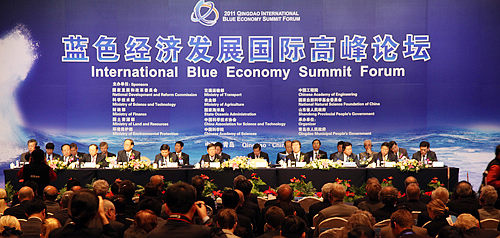|
 |
|
MEETING OF BLUE MINDS: The 2011 Qingdao International Blue Economy Summit Forum gathers experts to discuss issues on the blue economy (CFP) |
If left unprocessed, 10 tons of codfish skins sell for only 14,000 yuan ($2,215). However, Shandong Oriental Ocean Sci-Tech Co. Ltd., by cooperating with Yantai Institute of Coastal Zone Research affiliated to the Chinese Academy of Sciences (CAS), can turn 14,000 yuan into 400,000 yuan ($63,000) by using the fish skins to produce collagen proteins. This in turn can be processed into high-end health foods worth 12.5 million yuan ($1.98 million).
Examples of Shandong Province's exploitation of its marine resources were seen at the 2011 Qingdao International Blue Economy Summit Forum held on October 28-29.
Al Bryant, Vice President of Boeing Research and Technology in China, said his company has established a research project of extracting fuels from seaweed by cooperating with the Institute of Oceanology of the CAS in Qingdao. A commercial platform that produces biofuel by using seaweed is under construction in the city.
Bryant said a Chinese aircraft using biofuel had launched the first test flight on October 28 and the biofuel industry is expected to realize scale production by 2020. At that time, 30 percent of the fuels in the Chinese aviation industry will be biofuels.
"Experiencing the previous round of economic growth, China's coastal areas face slowed growth and many eastern provinces are looking for new growth points. With most land resources already exploited, the marine economy naturally has become the only option to expand that growth for the coastal regions," said Gao Ruxi, professor at Antai College of Economics and Management of Shanghai Jiao Tong University.
Coastal areas should not compete for resources with inland areas in the central and western regions, since coastal areas themselves have abundant marine resources.
"The regional development in China should be extended to the ocean and we should make overall planning for both land and marine development," said Chang Xiuze, professor at the Academy of Macroeconomic Research of the National Development and Reform Commission.
According to the Statistical Communiqué on Marine Economy of China 2010 compiled by the State Oceanic Administration (SOA), China's gross product of the marine economy totaled 3.84 trillion yuan ($607.59 billion) in 2010, a year-on-year increase of 12.8 percent, higher than the 10.3-percent GDP growth in the country. The marine economy contributed 9.7 percent to China's 2010 GDP, much higher than the 4 percent in 2006.
China has strengthened construction of the blue economy and approved several regional development plans for that economy. On January 4, the State Council approved the Development Planning for Shandong Peninsula Blue Economic Zone as part of the national development strategy.
It is the country's first regional development strategy of the blue economy and the first national-level development strategy approved in the beginning year of the 12th Five-Year Plan (2011-15). According to the plan, Shandong Province will coordinate the development of its land and marine economies and strengthen emerging marine industries.
The State Council also approved the Planning for the Zhejiang Oceanic Economy Development Demonstration Area in March and the Development Planning for Guangdong Oceanic Economy Comprehensive Experimental Area in July.
Shandong peninsula—with a coast line of 3,345 km and more than 200 bays, 50 of which can be turned into ports that can handle 10,000 tons or more—is the biggest in China. There are more than 320 islands whose area is above 500 square meters, most of which are not yet developed.
According to the Development Planning for Shandong Peninsula Blue Economic Zone, all offshore waters of Shandong Province with an area of 159,500 square km are covered in the economic zone. It also covers 64,000 square km of land that includes six cities—Qingdao, Dongying, Yantai, Weifang, Weihai, Rizhao—and two coastal counties in Binzhou. In 2010, this zone had a population of 33.15 million and a GDP of 1.87 trillion yuan ($295.89 billion).
"In the first half of this year, the Shandong Peninsula Blue Economic Zone had a GDP of 1.04 trillion yuan ($164.56 billion), up 11.7 percent compared with the same period last year," said Jiang Daming, Governor of Shandong Province, at the forum.
Compared with Zhejiang and Guangdong provinces, Shandong has marked advantages in marine science and technology. According to Jiang, the province has the strongest strength of marine scientific research in the country.
| 